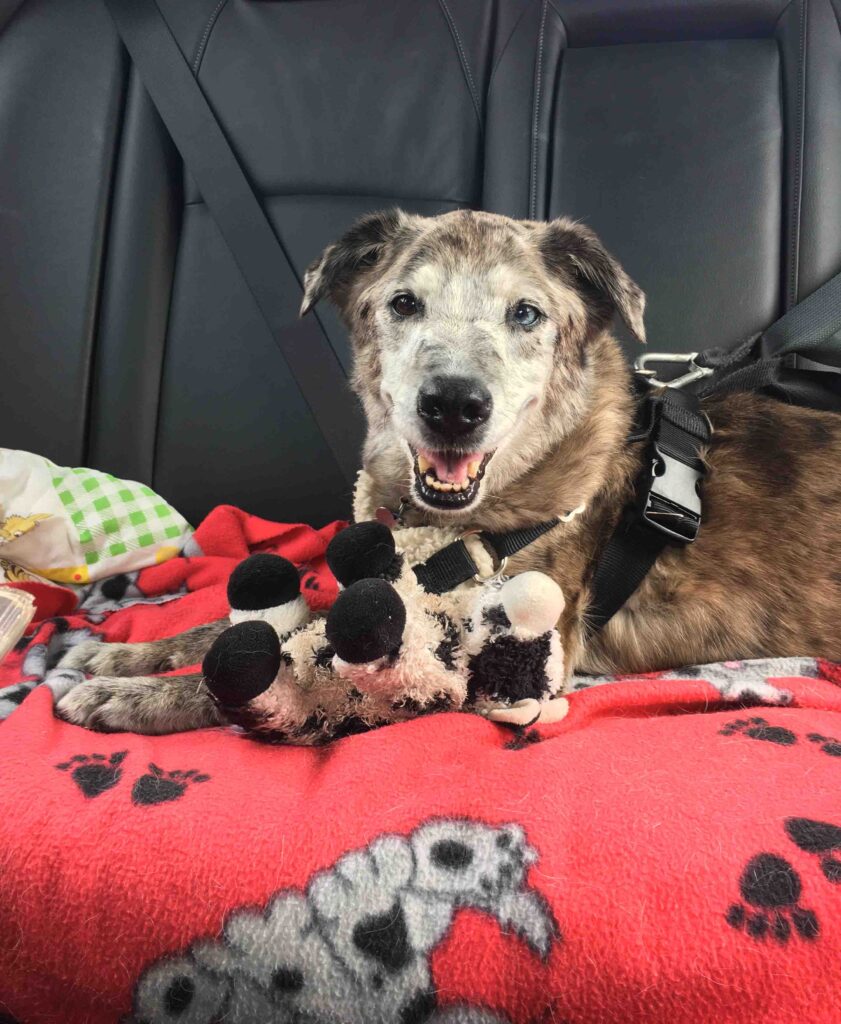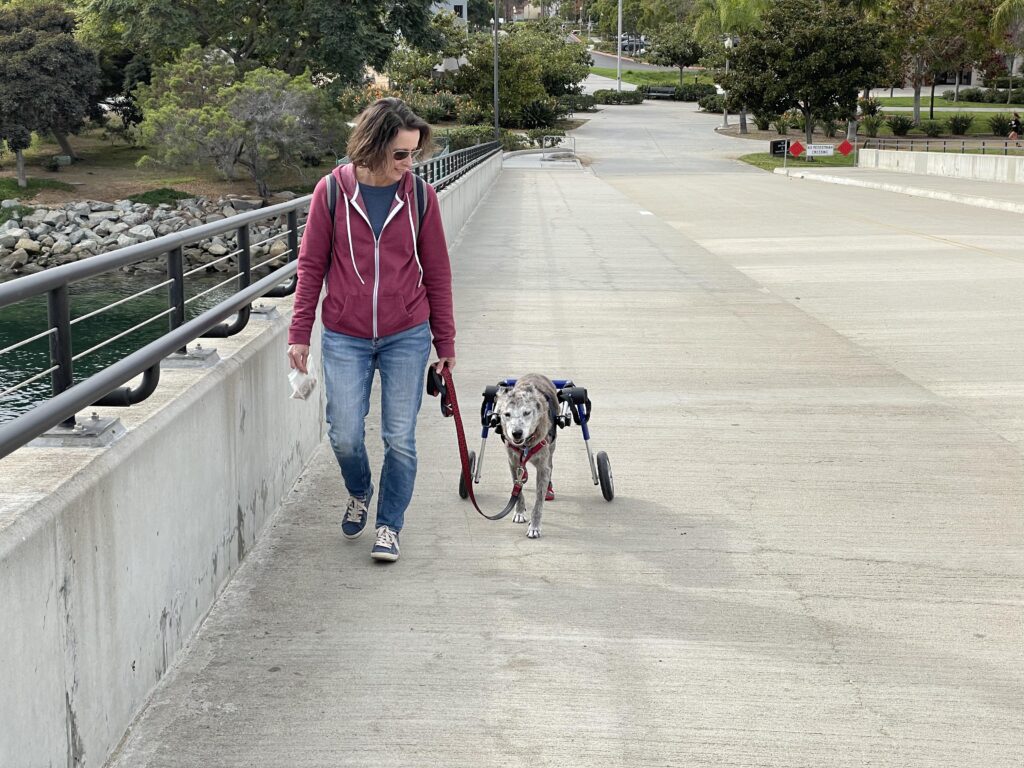I had never heard of Geriatric Onset Laryngeal Paralysis Polyneuropathy (GOLPP) until I googled Karlie’s symptoms. We had been to the vet earlier in the year trying to figure out why she was slowing down so quickly. At first we thought it was arthritis and the natural aging process. Then she started to have exercise intolerance, gagged/coughed after drinking and eating, and started to lose her bark. The information I found on the internet convinced me she had GOLPP. When we took her to the vet after an episode of vomiting I asked if this was possible. At first they did not think so, but when I talked about the honking bark and they saw some anomalies on a neck x-ray, we were sent to a board certified surgeon for a consultation. The surgeon diagnosed her based on her symptoms and the x-ray.

What is GOLPP?
To understand GOLPP, you need to first understand the larynx and how it works. The larynx is a structure with an oblong vertical opening located at the top of the throat. It opens and closes to allow breathing and swallowing. When open it allows air to pass in and out of the lungs; when closed it prevents food, water, and air from passing into the trachea. A dog with Laryngeal Paralysis (Lar Par) will have a larynx that can not open fully. This can cause noisy breathing, including loud snoring, panting excessively, exercise intolerance, and changing/loss of bark. Some dogs may experience breathing crises and even collapse. Lar Par can occur on its own or be part of a syndrome called GOLPP.
GOLPP is a degenerative disease of the longer nerves in the body and results in impairment of the esophagus, larynx, and hind legs. Sadly the cause is unknown and there is no cure. Symptoms may include hind end weakness, loss of muscle mass, dragging back feet when walking, lip licking, gagging/coughing, difficulty breathing especially when excited or in hot, humid weather, exercise intolerance, and change in bark. GOLPP is primarily diagnosed by an observation of the movement of the larynx under light sedation. Other tests may include chest and neck x-rays and a neurological exam of gait, muscle tone, and reflexes.
Treating GOLPP
There are several ways to treat GOLPP. There are two surgical procedures to address the laryngeal paralysis – arytenoid laryngoplasty surgery (tie back) and bilateral vocal fold excision and bilateral arytenoidpexy (BVEAP). Tie back surgery permanently opens one side of the larynx cartilage which increases air flow and improves breathing. Unfortunately, it increases the risk of aspiration pneumonia as the larynx can no longer protect food and water from entering the trachea. BVEAP surgery removes the vocal cords and fixes the arytenoid cartilages to the thyroid cartilage. This opens the larynx in a more conservative way and reduces the potential for aspiration pneumonia. Neither of these surgeries addresses the polyneuropathy which impacts the esophagus and hind legs.
Dogs with GOLPP generally experience esophageal dysfunction. Food and fluids do not travel quickly down the esophagus to the stomach and may come back up or cause acid reflux. Symptoms include lip licking, drooling, burping, swallowing rapidly, eating grass aggressively, sitting up and panting after lying down, or restlessness. Medications, such as ranitidine, erythromycin, cisapride, and metoclopromide, may be prescribed to stimulate the stomach to empty. Medications such as famotidine, cimetidine, omeprazole may also be prescribed to reduce acid reflux, but these do not stimulate stomach movement or emptying.
In addition to laryngeal paralysis and esophageal dysfunction, many dogs with GOLPP experience hind leg weakness and loss of muscle mass. They may struggle to get up or lay down, shuffle their back legs, drag their toes (knuckling), or have difficulty getting up on furniture. Physical therapy exercises, underwater treadmill, and acupuncture may help combat the progression.
The Progression of GOLPP
The progression of the disease is not the same for every dog. Karlie’s first symptoms were related to exercise intolerance and acid reflux, but as the disease progressed, hind end weakness was our biggest battle. Although Karlie could no longer climb mountains and take long walks (we were used to walking at least three miles twice a day), she didn’t have the breathing issues that many GOLPP dogs do. When we consulted with the board certified surgeon about tie back surgery he asked me what was my goal in treating Karlie. My answer was to get back the dog who could climb mountains. He told me that would not happen as tie back surgery would not impact the progression of her hind end weakness, it would only address the function of her larynx. Since she did not have serious breathing issues, we opted to manage her symptoms instead of having tie back surgery. We were successful in doing this for nearly two years and are so thankful for that extra time with her.
What we did for Karlie
So what were Karlie’s symptoms and what did we do to manage them? Karlie’s symptoms were gagging/coughing after drinking and eating, periodic episodes of food fussiness, and hind end weakness. This started with not being able to get up on lounge chairs or the bed and progressed to difficulty getting up from sitting and taking a long time to lay down to not being able to support herself while urinating and defecating to falling down when playing ball to walking in circles (one leg was weaker than the other). The surgeon we consulted with suggested we give Karlie Prilosec to address the acid reflux. We started with half a pill with breakfast and another half with dinner, but eventually reduced it to just half a pill with breakfast. With a lot of trial and error I also discovered that five small meals a day were better than two large meals. At least one of the meals included mashed sweet potatoes or pumpkin as these are soothing to the stomach. I also found giving her something before going to bed helped. This is contrary to most information on treating acid reflux, but it worked for Karlie.
Treating Hind End Weakness
Our treatment of Karlie’s hind end weakness can be summarized with one phrase – keep moving. We continued to take her on walks, they were just shorter and earlier in the day when it was cool. We also took her hiking, kayaking, and on other adventures to give her something to look forward to. I brought water and even used a cooling vest. We did physical therapy at home – climbing over pillows, climbing over dowels supported between two cones (cavaletti), and climbing a ramp onto the bed. We played fetch every day. If it was too warm outside, we played inside. This worked for over a year and then one leg became weaker than the other which made it hard for her to walk a straight line. This made it difficult for her to go on walks which made her legs weaker. It was a vicious circle. I started to use a harness to help support her back end, but she didn’t like it. Then I purchased a rear-wheel wheelchair, which initially she did not like either. Over time she learned to use it and even enjoy it. Eventually she was able to walk two miles using it even on trails and in the mud. The best part, though, is the longer we used it, the less she needed it. It supported both legs and made her use them equally. This strengthened them and allowed her to walk up to 1.5 mile without it. For more information about her wheelchair, see the Got Wheels post.

Resources
Listed below are some resources that provide additional information about GOLPP. One of the best resources, however, is the LP/GOLPP Facebook Support Group. I highly recommend anyone who suspects their dog has GOLPP to join the group. I stumbled upon it during one of my many google searches and have found it to be a welcoming, caring group where you can ask questions about symptoms and treatment as well as get support during difficult times.
- Michigan State University – GOLPP
- Direct Veterinary Surgery – Flabby Esophagus and GOLPP
- Vet Education – Laryngeal Paralysis
